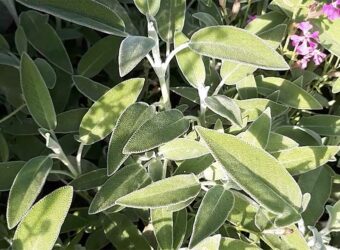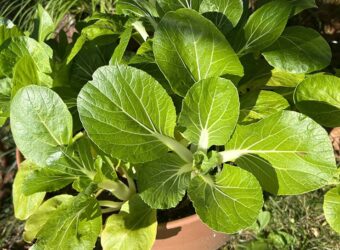Cucumbers are grown by a lot of people. Unfortunately, cucumbers are plagued with a variety of problems. This guide will give you the most common reasons for your plants to wilt and die.
When Will Wilting and Dying Happen?
Cucumbers are most vulnerable to wilting and dying when they are seedlings. They do not have very many plant cells, so if one dies, it affects the plant more than it would in a more mature plant with many plant cells. In addition, seedlings are relatively weak and have small root systems, so are more vulnerable than established cucumber plants. Mature cucumber vines are more resistant to diseases.
Wet weather can cause problems for two reasons. Saturated soil keeps the roots wet, and they may rot. Wet foliage is more likely to host fungal infections.
Cucumbers will wilt during the day and recover at night when dealing with drought and heat. Certain diseases also start with daytime wilting.
Most Common Reasons for Cucumber Wilting and Dying and Solutions
Some things that are not pests or diseases cause wilting and dying. While any disease will eventually cause cucumber plants to wilt and die if it is severe enough, there are some that are more common than others. The same is true for pests.
I am listing the most common problems in cucumbers where the first symptoms you see are wilting and dying.
Inadequate Water
The most frequent cause of wilting and dying cucumber vines is inadequate water. Cucumber vines need one to two inches of water a week. In mild climates, give your vines one inch of water once a week. In hotter climates, give them one inch of water twice a week. The goal is evenly moist soil. In addition to wilting, inadequate water causes bitter cucumbers.
Fertilizer Burn
Fertilizer burn is the second most common cause of wilting and dying cucumbers. More is not better with fertilizers. Too much nitrogen causes the leaves to turn brown and wilt, then die.
Over-fertilizing with nitrogen that doesn’t brown the leaves can cause wilting because the vine grows more foliage than the roots can supply water to. Phosphorus and potassium toxicity affect the plant’s ability to take up water and will cause wilting.
Too much can kill your cucumber. Follow the directions and use enough, but not too much, fertilizer.
Dampening Off (various)
Symptoms
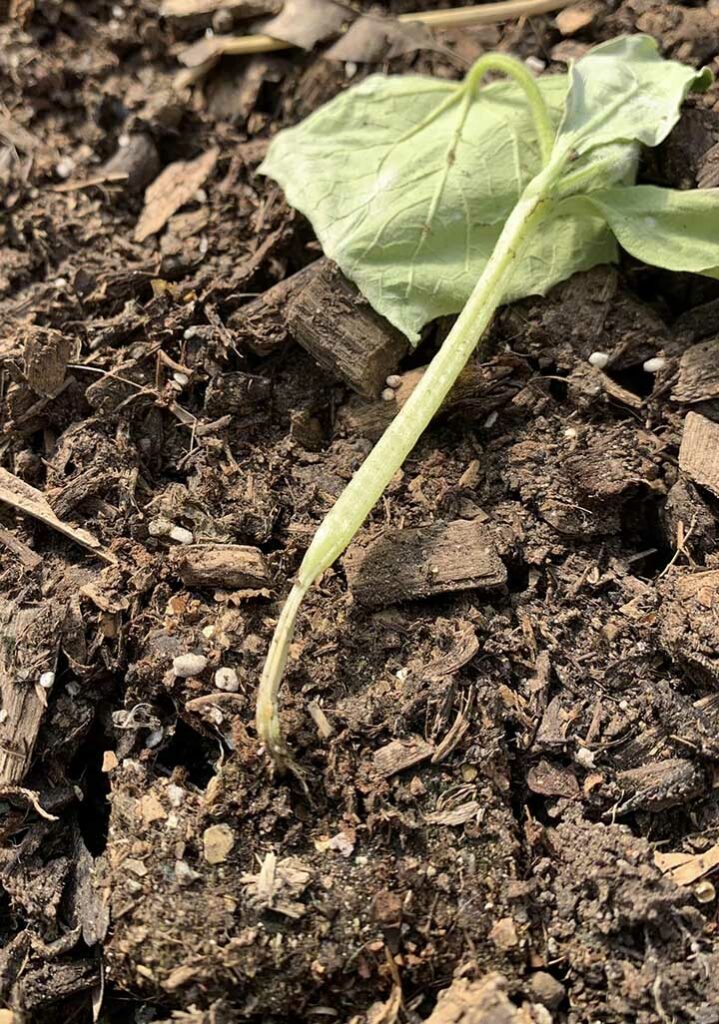
The seedling falls wilts rapidly and falls over. When seedlings are small, they are more vulnerable to diseases. Dampening off is caused by a fungus that causes a rot right at the soil line.
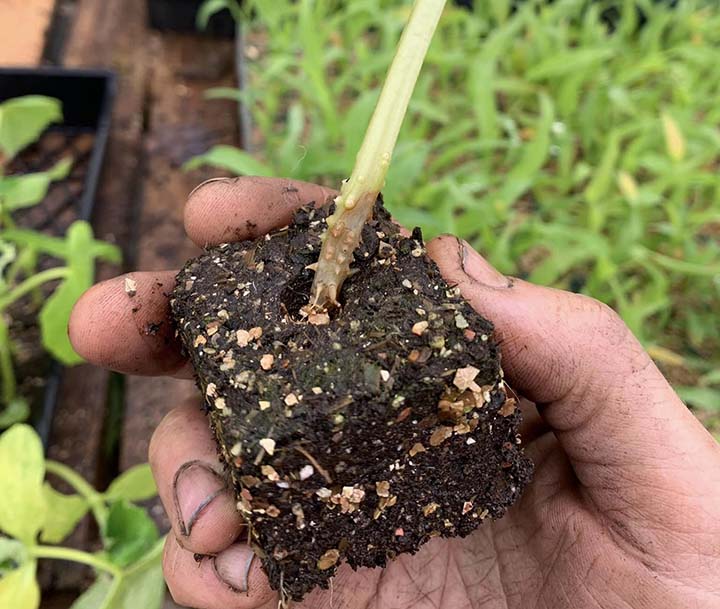
The cause is too damp soil. Once one seedling gets the dampening off fungus, the disease spreads rapidly through the whole tray of seedlings.
Treatment
There is no treatment for dampening off.
Prevention
- Keep the soil moist but not soggy, and wash your hands with soap before handling seedlings.
- Sterilize trays before reusing them, and use a sterile seed starting medium.
- Water from the bottom up to avoid getting the foliage wet.
Root Rot (various)
Symptoms

The leaves and vine wilt, especially during the day at first, then all the time. Root rot is caused by too wet conditions. Usually, it occurs after a period of prolonged rain, but sometimes it is caused by overwatering. The roots stay saturated, and a fungus grows on them, consuming the small root hairs and the covering of the larger root hairs. The leaves and vine wilt because the roots are not able to take up water and send it to them.
Treatment
Unfortunately, by the time symptoms of root rot occur, it is usually too late to save the plant.
Prevention
It is very important to plant cucumbers in an area that drains well so the roots do not stay saturated when it rains. Cucumbers need one to two inches of water a week. If the soil is kept wet, the roots cannot breathe, and fungus will grow on them. If you have difficulty telling when to water your cucumber vines, an inexpensive moisture meter is a great tool to use. You want the soil moisture to be in the middle part of the dial, not too dry or too wet.
Bacterial Wilt (Erwinia tracheiphila)
Symptoms

If your cucumber leaves appear dull green and wilt during the day but recover during the night, they might have bacterial wilt. Eventually, the leaves turn yellow and the edges brown.
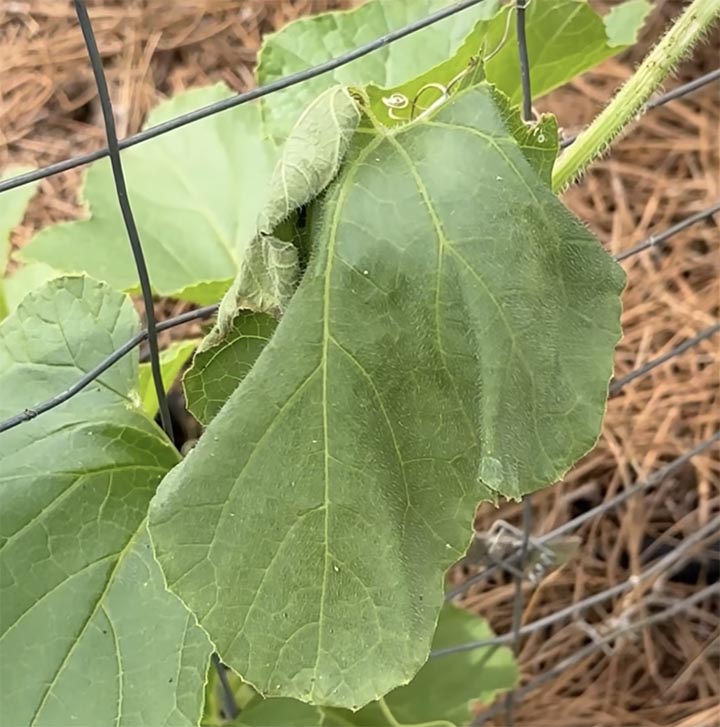
The leaves completely wither and die. Generally, the disease starts when a cucumber beetle bites a plant and infects it with the bacteria.
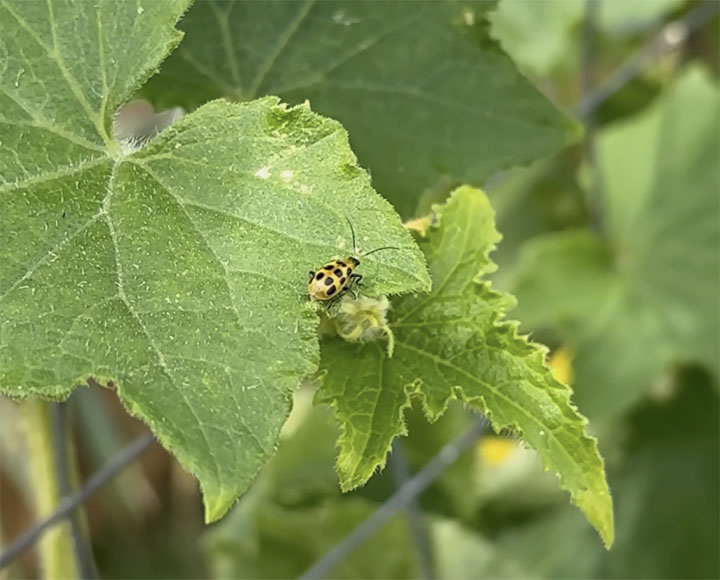
The bacteria multiply and plug the vascular system of the vine, cutting off water to the leaves above the plug. These leaves wither and die. The bacteria continue reproducing until all of the vine is plugged with them, killing the entire plant. In cucumbers, the entire plant wilts very quickly.
Treatment
There is no treatment for bacterial wilt. Remove the plant from the ground and dispose of it in the trash. Leaving the plant in the ground means more cucumber beetles will feed on it and pick up the bacteria to spread to other plants.
Prevention
Control cucumber beetles as soon as they appear. Neem oil can be used when the temperature is below 80F. Over 80F, it will burn your cucumber plants. Pyrethrins are derived from chrysanthemums and are allowed in organic gardening. Apply to the cucumber beetles as soon as they are seen. This pesticide kills on contact but doesn’t have much residual effect, so has to be reapplied frequently. You can use synthetic pyrethrins, but they are toxic to beneficial insects and have a residual effect, so they are more likely to kill bees and butterflies in addition to cucumber beetles. In addition, promptly remove spent plants so the adult cucumber beetles cannot overwinter on them.
Fusarium Wilt (Fusarium oxysporum forma specialis niveum)
Symptoms
Wilting, often on only one side or part of the plant. The cucumber vine may recover in the evening. Eventually, the leaves become yellow and die. The problem starts with the older foliage and then moves to the newer foliage. Eventually, the whole plant wilts and dies. If you cut the stem in half, the vascular system is brown and discolored. The vascular system is completely colonized by the Fusarium organism, blocking water from the roots to the leaves. The spores live in the soil and become active in warm, wet conditions. They colonize the roots through injuries or through the root cortex.
Treatment
There is no treatment for Fusarium wilt.
Prevention
Plant-resistant varieties of cucumbers. Rotate crops to prevent the buildup of wilt fungi. Remove plants at the end of the season, so wilt fungus doesn’t linger in them. Destroy (in the trash) plants that have wilt. Buy seeds and transplants that are certified disease-free. If you reuse pots and trays, sterilize them for 30 minutes in a solution of one part bleach and nine parts water before reusing them.
Verticillium Wilt (Verticillium dahliae or V. albo-atrum)
Symptoms
Wilting and yellowing of crown leaves. Eventually, the wilting and yellowing extends down the entire length of the vine. The entire plant may die if the infection is severe. Verticillium wilt is worse when the temperature is 70-85F, and the soil is wet. The organism invades the roots and then grows in the xylem, choking the plant’s vascular system and reducing or stopping water delivery to the leaves.
Treatment
There is no treatment for Verticillium wilt.
Prevention
The prevention of Verticillium wilt is the same as the prevention of Fusarium wilt. Resistant varieties may show symptoms of the disease without dying.
Squash Vine Borers (Melittia cucurbitae)
Symptoms

Wilting and death of a runner, including both the vine and leaves. Wilting may be gradual or sudden. The vine may be chewed through and broken when the squash vine borer exits the vine.
What is it?
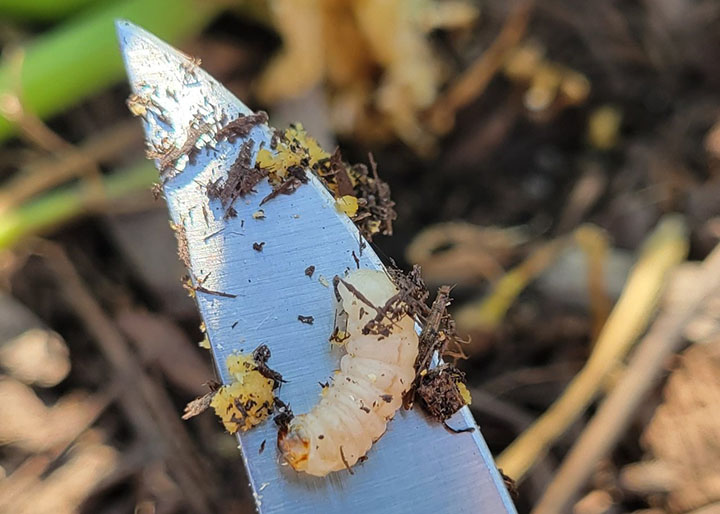
The squash vine borer is a day-flying moth that looks like a wasp. It lays tiny eggs at the base of vines, where leaves meet vines, and at the base of the plant. When the eggs hatch, the larvae immediately bore into the vine. They eat the inside of the vine as they mature. When they are ready to pupate, they chew through the vine to exit and burrow in the soil. Most people notice frass (insect poop) coming from holes near the base of the vine first. If the vine is cut open, one or more white larvae are inside.
Treatment
Because the vine borer is inside the vine, most insecticides will not penetrate enough to kill it. By the time the larva is discovered, it is usually too late to save that runner or vine.
Prevention
Squash vine borers are difficult to control and prevent. You can try wrapping the base of the vine with foil or stripes of cloth. Watch for signs of the adult moth at dusk and dawn and destroy them. Spray the base of the vine with a contact poison that has a residual and will kill the larvae as they bore into the vine. Till the soil after the season is over to turn up and kill the pupae and adults trying to over winter. Rotate your crops to a non-cucurbit for three years.
How Do I Minimize the Risk of Your Cucumber Dying?
You can prevent most pests and diseases with careful cultural practices and the judicious use of pesticides. Here are my tips to minimize the risk of your cucumber dying.
- Plant cucumber varieties that are resistant to the cucumber diseases that are common in your area. Your Extension agent can suggest some varieties that grow well in your area. You can check the disease resistance of cucumber varieties on the Cornell University website.
- Buy your seeds and transplants from a reputable dealer that certifies them to be disease-free. This is especially important with verticillium and fusarium wilt. You do not want to introduce these diseases into your garden because they attack many, many types of plants.
- Pick where you plant your cucumbers carefully to ensure they get eight or more hours of sun and will grow in well-drained soil. Mix organic matter into the soil in the form of compost to increase the soil’s ability to absorb water. Do not plant cucumbers where water will pool during a rain.
- Plant your cucumbers on hills that are about four inches tall and four inches in diameter to further improve drainage. Doing this helps when it rains heavily by lifting the roots out of the pooled water.
- Plant cucumber vines with at least six feet between rows so that the vines can spread out but there is space between vines for air to circulate. Air circulation helps dry the foliage and prevent fungal diseases. Space hills two feet apart in the row.
- Trellising your vines helps keep them off the dirt and improves air circulation. It also prevents belly rot in the cucumbers and saves space.
- While you plant four seeds per hill, it is important to thin the seedlings to the healthiest two seedlings per hill by pinching off the weaker seedlings. Do not pull them up, or you will damage the roots of the strong seedlings.
- Follow the directions on the fertilizer you use with your cucumber vines, and do not over-fertilize.
- Never get the cucumber foliage wet when watering. Use drip irrigation or a soaker hose to water from the bottom, at the root zone. If you must use a sprinkler to water your cucumber vines, water before ten a.m. so the foliage will dry by nightfall.
In conclusion, there are a number of things that can cause your cucumber plant to wilt and die. Lack of water and over-fertilization are the two biggest culprits. The squash vine borer is a pest that causes vines to wilt and die. There are a number of diseases that do so as well. Careful cultural practices can prevent most problems that cause a cucumber to wilt and die. Planting resistant varieties, allowing adequate space between vines, and removing spent vines promptly are the most effective ways to prevent diseases that cause wilting and dying.
